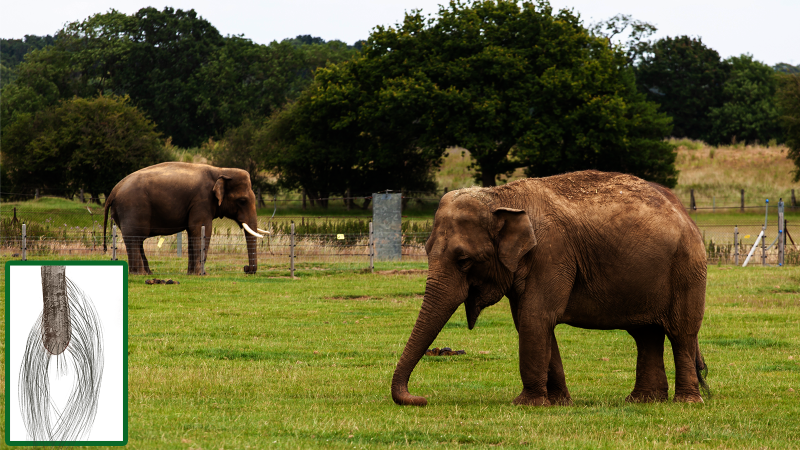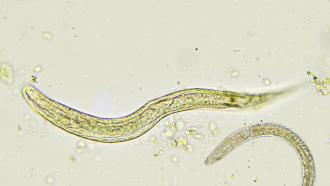
Image credits: Elephant Image from Pixabay; inset graphic by Savitha Sekhar, Research Matters
Asian elephants (Elephas maximus) in the wild are social animals. Females live in herds headed by a matriarch and forage and move together. Adult males, who are solitary or live in small bachelor groups, join the females during mating season and leave soon after. Captive elephants, unlike their wild counterparts, are confined to small spaces. While their food, water, and health are often taken care of, they are socially isolated from other elephants, which could take a toll on their well-being. Do these captive elephants undergo stress? If so, how can we know? It turns out that their tail hair tells their tale of stress.
Body hair in elephants and other mammals not only regulates body temperature but also contains traces of stress hormones called immunoreactive cortisol. In a collaborative study, researchers from India and Japan show that the tail hair of captive Asian elephants accumulated stress hormones that could be measured. This study, published in the journal PeerJ, is the first to use tail hair as a stress indicator in large mammals in Asia and shows that tail hair can be an effective tool in monitoring stress levels in captive elephants.
The tail-hair of Asian elephants has been used to analyse their dietary history, migration patterns, and chronology. Previous studies that monitored stress in animals used faeces, urine, and blood samples. While these are valid techniques, they have a drawback.
“Stress measured using metabolites in faeces, hormones in blood and urine provide us with a measure of stress levels of either the same day or up to the previous 12 to 36 hours. With hair, we can trace back the stress levels to the past,” says Dr Sanjeeta Sharma Pokharel, the first author of the study.
There are other benefits to using hair samples. Unlike drawing blood, which could be a painful and stressful procedure for the animal, collecting hair is non-invasive with minimal discomfort during extraction. In addition, the researchers preferred tail hair over other body hair as they are thicker and longer. “The elephant’s body hair is used for thermoregulation, while the tail, being highly flexible, functions to keep the ectoparasites (such as flies and ticks) away from the skin and hence has thicker hair,” explains Dr Pokharel.
The researchers conducted their experiments on six Asian elephants from two zoos in Japan —the Kyoto City Zoo and the Kobe Oji Zoo. First, they measured the growth rate of tail hair in the elephants. They then collected the tail hair samples of the elephants by cutting a few hair strands close to the skin, ensuring they caused no damage to the skin or hair follicle during the process. The researchers adhered to animal ethical rights during the sample collection process. They then extracted the cortisol hormones from the collected hair strands.
They observed that the hair growth rate was different for all six individuals. However, this rate stays the same for each individual over time. The researchers also calculated each individual’s hair growth rate per day, based on which the collected hair strands were cut into month-wise segments for stress analysis.
“In animals with longer and rapidly growing hair, we could trace back stress levels to long past periods. For example, in one of the elephants, we were able to trace back up to the previous three years,” explains Dr Pokharel.
For each elephant, they compared the elephant’s previous health record and other biological events (maintained by zookeepers) with the stress hormone patterns over a time period. They observed that records of pathological stressors such as infections, injuries, anaemia, and oral sores; psychosocial stressors such as reluctance to enter the enclosure; and reproductive stressors like coming into heat coincided with high cortisol level measurements. At the same time, periods of relief provided by social interactions with other elephants, suitable housing and living conditions lowered the cortisol levels.
The researchers say that tail hair can now be used to study stress levels and understand the effects of retrospective events on individual animals. In addition, analysing cortisol levels in hair strands from dead elephants can provide insights into their living conditions and answer broader ecological questions. “For instance, if we find cortisol peaking in the hair segments corresponding to previous years where there were incidents of drought, fire, or disease outbreaks, we can visualise the past incidences and their influences on the animal,'' explains Dr Pokharel.
The researchers suggest that further studies on more individuals, experimenting with different extraction and analytical techniques might provide better insights. They say that studying the cortisol levels in an array of faecal, urine, and blood samples and comparing them with the hair samples data will validate the use of hair samples as a stress analyser in captive Asian elephants. “We are now intending to collaborate with the zoos that have been inspecting the cortisol levels through other matrices and hence, advance the prospect of this study to address different sets of physiological questions,” signs off Dr Pokharel.
This article has been run past the researchers, whose work is covered, to ensure accuracy.
This article was edited to correct a spelling error. The error is regretted.






